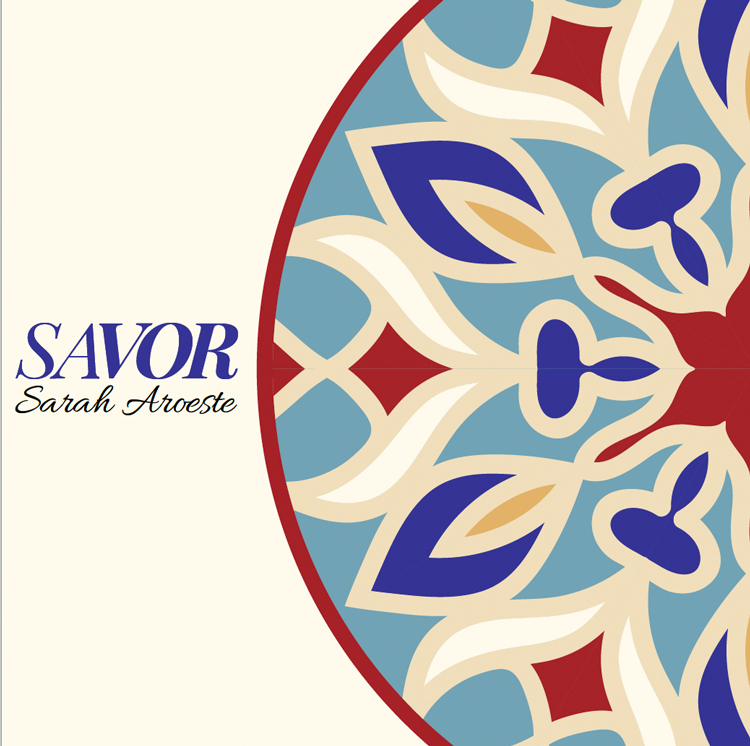Sarah Aroeste – Savor (2023)
The intersection of music and cuisine lies at the heart of Sephardic culture and tradition. These two distinct sensory experiences have endured throughout the centuries and continue to unite Sephardic Jews around the world, despite the changes in time and borders.
Enter “Savor,” a multisensory project led by singer Sarah Aroeste that brings together Sephardic songs and dishes uniquely. Each song on the album revolves around a specific food item that holds a special place in Sephardic life. The songs are arranged into a musical menu of mezés (appetizers), plato prinsipal (main course), and dulse (dessert). Each track is paired with a dish crafted by a female chef, in partnership with Chef Susan Barocas, who emphasizes Sephardic culture in her cooking. The recipes draw inspiration from the highlighted foods in each song and offer options for vegans, vegetarians, fish lovers, chicken enthusiasts, and meat eaters. As you listen and peruse the lyrics, you will discover the food being celebrated and the matching recipe.
As you delve into this album, you will find that the songs reveal the lives of Sephardic women through the foods they cooked and nurtured for generations. Through these tales and foods, you can literally taste how Sephardic women lived.
Sarah Aroeste describes the songs:
Starting with the mezés, Track 1 (Una muchacha en Selanika) tells the story of a Sephardic girl who was compelled to convert to Islam because she could not properly prepare stuffed grape leaves.
Track 2 (Siete modos de guisar la berenjena) presents seven different ways in which women can prepare eggplant, with longer versions that enumerate over thirty.
Track 3 (La envenenadora) is part of the Sephardic song tradition of romances, epic tales of high drama. In this song, a girl poisons her lover in the forest and tries to revive him with chicken soup when he wakes up in agony.
Track 4 (Chiko Ianiko) is the only song on the album not of traditional origin but was composed by the late Flory Jagoda z”l, who wrote the song about the pleasure of baking burekas with her grandchild. I sing this sweet song with my two young daughters.
Track 5 (Viva Orduenya) is a traditional song that accompanies a wedding dance, connecting the act of baking bread – from sowing the seeds to harvesting, kneading, etc. – with female fertility.
Moving on to the plato prinsipal, Track 6 (El Dio la mate esta Grega) is a mash-up of a well-known Sephardic song and a more obscure one. The former, “La cantiga del fuego,” is a song from Salonika, Greece that laments the tragic fire of 1917 that destroyed the Jewish quarter and left much of Salonika in ruins. Many people accused Jews of causing the fire because of their disregard for the Sabbath. The second song, a joke, pokes fun at such a ridiculous accusation by claiming that a woman in the kitchen started the fire by burning the eggplant she was roasting.
Track 7 (Debate de las komidas) is part of the Sephardic song tradition of coplas, Spanish musical poems about historical events and holidays. Based on a copla for the spring festival of Tu B’shvat, in which different flowers debate their virtues, here the debate, akin to a beauty pageant, is about which food item is the best!
Track 8, also known as Ke Komiash Duenya, hails from Bulgaria and is a ditty that tallies up the lady of the house’s Passover supper menu, akin to the classic carol “The Twelve Days of Christmas”. This song commences after the third night, possibly a custom of Spanish Anusim (secret Jews) to evade detection by the Inquisition.
Track 9, Peshkado Frito, has its roots in Morocco and humorously tells the tale of Jacob, the fishmonger, who fries his fish in his wife Mazaltov’s oven.
As for Track 10, Si Veriash a la Rana, it features three kitchen-bound sisters (depicted as a frog, a mouse, and a camel) as they prepare a scrumptious dessert by rolling out phyllo dough (also known as filo) and shelling walnuts.
Sarah Aroeste says: “As varied are the flavors of the foods in the songs, so are the musical sounds. From Greek bouzouki to Balkan brass, Moroccan rhythms, fresh beats and more, the Ladino songs also include specific words in Turkish, Haketia and other dialects. While most of the songs are transcribed in a standard Ladino form, I have chosen to leave certain phrases written and pronounced as per my song sources to keep their unique essences.”
Buy Savor.


